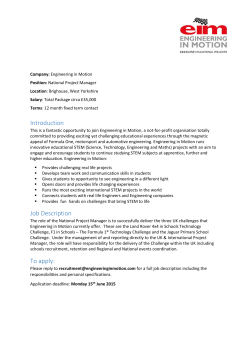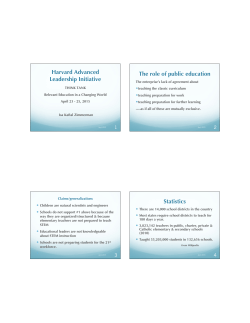
PDF Plant Stem Cell Extract for Longevity of Skin and Hair
5-2008 English Edition International Journal for Applied Science • Personal Care • Detergents • Specialties D. Schmid, C. Schürch, P. Blum, E. Belser, F. Zülli: Plant Stem Cell Extract for Longevity of Skin and Hair CO S M ET I C S ST E M C E L L S D. Schmid, C. Schürch, P. Blum, E. Belser, F. Zülli* Plant Stem Cell Extract for Longevity of Skin and Hair Keywords: stem cells, anti-aging, plant cell culture, senescence, hair follicles Introduction What are Stem Cells? Stem cells are unprogrammed cells that can differentiate into cells with specific functions. Stem cells have therefore a big potential in regenerative medicine. Regenerative therapies are used to stimulate healing and might be used in the future to treat Parkinson’s, Alzheimer’s or Summary tem cells of an old apple cultivar with very good storage properties were produced by applying plant cell culture technique. The extract of the cultured apple stem cells was shown to enhance the viability of umbilical cord blood stem cells, to reverse senescence signs in human fibroblast cells and to increase lifespan of isolated human hair follicles. PhytoCellTech™ Malus Domestica, a cosmetic ingredient based on encapsulated extract of cultured apple stem cells, was tested in a clinical trial over 4 weeks with 20 subjects. This new ingredient was found to significantly reduce wrinkles in the crow’s feet area. S diabetes. Regenerative medicine will result in an extended healthy life span. Stem cell research is now a fascinating, hot topic that is already used in cosmetics. Amatokin, a face care product line of Voss Laboratories, is claimed to stimulate the stem cells in the skin. And Dior’s Capture R60/80 XP range are anti-wrinkle products whose mechanism of action is based on protection of the life force of stem cells. So what exactly are stem cells? The main principles that define stem cell populations include: (I) the capacity to replenish themselves through self-renewal and (II) the ability to generate differentiated cells. There are two types of stem cells in animals and humans: embryonic stem cells and adult stem cells. Embryonic stem cells are pluripotent and thus can differentiate into all cell types of the body. The role of adult stem cells is to maintain and repair tissues. They are more restricted and normally able to differentiate only into the different cell types of the tissue in which they are found. But there exist also adult stem cells with a pluripotent differentiation potential. They are the focus of the newest research because there are no ethical concerns with adult stem cells. Each cell, whether stem cell or differentiated cell, has the same DNA, meaning the same genes. So what makes a stem cell a stem cell? Their characteristics depend on signals from the microenvirone- Epidermal layer Basal layer Sebaceous gland Outer root sheath Inner root sheath Hair shaft Hair follicle matrix Hair bulge stem cells Dermal papilla Fig. 1 The hair bulge contains multipotent stem cells that contribute to the lineages of the epidermis, the sebaceous gland and the hair follicle 30 SÖFW-Journal | 134 | 5-2008 CO S M ET I C S ST E M C E L L S ment, i.e. from the neighbouring cells that form a kind of niche. But principally there are signals inside the cell that control their fate. These signals are called epigenetic signals. In brief, these are tags on the DNA or the surrounding histone proteins that regulate the switching on or off of genes. The Role of Stem Cells in the Skin The skin is actually the largest organ in the human body. It is covered by the epidermis, a stratified epithelium. The epidermis comprises the interfollicular epidermis, the hair follicles and the sebaceous glands. Because the terminally differentiated cells in the epidermis are shed from the skin, there must be a continuous delivery of newly differentiating cells. This shows the importance of stem cells in the skin. There is strong evidence that the hair bulge forms a reservoir of epidermal stem cells (Fig. 1). From there, stem cells periodically migrate to the matrix of the hair follicle, the sebaceous gland and the basal layer in the interfollicular epidermis (shown with dashed pink lines) to produce progenitors that differentiate into hair cells, gland cells or cells of the upper epidermal layers respectively (shown with dashed green lines) (1). The basal layer of the epidermis contains two different types of cell populations (Fig. 2): (I) the slowly dividing epidermal stem cells and (II) their progeny that are rapidly dividing cells in order to supply new cells to replace those that get lost by desquamation. After a limited number of divisions, they detach from the basement membrane and start the differentiation program leading finally to stratum corneum cells. Newest studies showed that the stem cells might comprise 2 – 7% of the basal layer cells. The fact that the self-renewal of the epidermal stem cell is slow, is important, because they die after a certain number of divisions and because each division bears the risk of lethal DNA mutations. And loss of stem cells is by far more detrimental for the tissue than when we lose differentiated cells. Hair graying for example could be shown to result from the fact that the melanocyte stem cells in the hair follicle have died off (2). Plant Stem Cells and their Propagation in Culture Plants also have stem cells. Two populations of stem cells, one comprising the shoot apical meristem and the other the root apical meristem, give rise to the plant body. The maintenance of stem Stratum corneum Granular layer Spinous layer Basal layer Dermis Epidermal stem cell Transient amplifying cells Basement membrane Fig. 2 Epidermal stem cell generates transit amplifying cells that differentiate to form the stratified layers SÖFW-Journal | 134 | 5-2008 cells in plants is also dependent upon signals from the microenvironment and on similar epigenetic control as in mammalian stem cells (3). Unlike humans, adult plants contain totipotent stem cells with the potential to regenerate a whole plant. The plant tissue culture technique is based on propagation of plant stem cells either to produce a whole plant, only tissue or just single cells in culture to harvest plant metabolites. This practice allows the production of plant material under sterile and standardized conditions independent of season and other environmental restraints. Plant tissue cultures can be initiated from nearly all plant tissues. The tissue material which is obtained from the plant to culture is called an explant. As a kind of wound reaction, new cells are formed on the cut surfaces of the explant. The cells slowly divide to form a colorless cell mass which is called callus. These cells have dedifferentiated into cells that lack the distinctive features of normal plant cells. Callus cells are stem cells comparable to those in the meristem regions. For high yield production callus cells can be cultured as individual cells or small cell clusters in a liquid culture. Apple Stem Cells of Cultivar with Excellent Storage Properties A fresh apple is a symbol for beautiful skin. Apples with very good storage properties stay fresh over months. These apples must have especially long-living tissue stem cells. Could we profit from these stem cells? What would be the effect of an extract of such long-living stem cells on the skin? But the commercially available apples are not suited for long storage. They are selected for intensive cultivation and for a pleasant sweet flavor. In former times, good storage properties were an important factor for cultivar selection. Some of these old cultivars survived as isolated trees in areas with less intensive agriculture. The Uttwiler Spätlauber is an apple tree that was cultivated especially because of its good storage properties (Fig. 3). The Spätlauber variety derives from a seedling that was planted in the middle of the 18th century. There are still some Uttwiler Spätlauber trees 31 CO S M ET I C S ST E M C E L L S Fig. 3 Isolated Uttwiler Spätlauber tree found in the Zimmerberg region at the lake of Zürich. left in certain areas in Switzerland. The apples of one of these trees were used to obtain tissue explants in order to initiate a plant cell culture. A success full liquid culture in bioreactors of Uttwiler Spätlauber stem cells could be established. An extract of these cells was tested in a series of studies for anti-aging efficacy in skin and hair. Matrials and Methods Plant cell cultures Apples of the Uttwiler Spätlauber variety were used for selection of suitable plant material. Callus induction and subcultivation was carried out according to standard protocols. Incorporation of the dedifferentiated cells in an appropriate liquid media, homogenisation of the cells in suspension and continuous characterisation of the cell suspension was also carried out according to standard procedures. For up-scaling, 10% of the next larger culture volume of a fully grown cell suspension was used as inoculum. Production of biomass was done in 50 to 100 l cultures with a special bioreactor-system (Wave-Biotech AG, Tagelswangen, Switzerland). Cultivation was done at 25 °C and an aeration of 0.1 vvm. Biomass production was monitored by analysis of total sugar concentration, conductivity, pH-value and optical density. Production of secondary metabolites was followed by HPLC and UV/VIS analysis. The extract of Uttwiler Spätlauber stem cells was obtained after lysis of the plant cells using high pressure homogenisation. For preparation of PhytoCellTech™ Malus Domestica, the etract was incorporated into lecithin liposomes. The composition of PhytoCellTech™ Malus Domestica is the following (INCI): Malus Domestica Fruit Cell Culture, Xanthan Gum, Glycerin, Lecithin, Phenoxyethanol and Aqua. Fig. 4 Effect of Uttwiler Spätlauber stem cell extract on viability of umbilical cord blood stem cells 32 Results and Discussion Protection of Human Stem Cells Stem cells from umbilical cord blood represent an ethically correct source of human stem cells. An extract of Uttwiler Spätlauber stem cells was tested on cell viability of umbilical cord blood stem cells in two different studies. First, the effect of the extract on the proliferative activity of the human stem cells was analyzed. There was a clear, concentration-dependent effect found (Fig. 4). At only 0.1%, the extract stimulated cell proliferation by 80%. In a second experiment, the stem cells were stressed through irradiation with UV light. Almost 50% of the cells that were cultured in the growth medium alone died, whereas cells cultured in presence of an extract of Uttwiler Spätlauber experienced only a small loss of viability (Fig. 5). Reversion of Senescence Signs in Fibroblast Cells Senescence is a natural process that, after about 50 divisions, stops the capacity of the cell to undergo further divisions. But senescence can also happen earlier in a cell’s life, for example as response to damage to the cellular DNA. Premature senescence is especially detri- Fig. 5 Uttwiler Spätlauber stem cell extract protects umbilical cord blood stem cells against UV light SÖFW-Journal | 134 | 5-2008 CO S M ET I C S ST E M C E L L S mental when it hits stem cells because they are indispensable for tissue regeneration. Recently a cellular model for premature senescence was established based on fibroblast cells. After a two hour treatment with H2O2, the cells showed the typical signs of senescence. This model was used to prove an anti-senescence effect of an extract of Uttwiler Spätlauber stem cells. After the H2O2 treatment, the fibroblast cells were incubated with 2% extract for 144 hours. Then gene expression was analyzed with a cDNA array system comprising of 150 probes related to cellular growth, signaling, senescence and aging. Gene expression was compared to that of cells that were kept only in the culture medium after the H2O2 treatment. In the control culture, several genes important for cellular proliferation and stimulation of cellular growth were down regulated after H2O2 treatment (Table 1). Incubation with the extract of Uttwiler Spätlauber stem cells neutralized this down regulation or even induced an up regulation. The extract also strongly stimulated the expression of an important antioxidant enzyme, heme oxigenase 1, whose expression was surprisingly not increased in the control. Retardation of Senescence in Isolated Hair Follicles Human hair follicles can be isolated by microdissection from skin fragments that are left after facelift surgery. Only follicles in the anagen phase are collected. Hair follicles are mini organs that represent a natural coculture model of epidermal and melanocyte stem cells and differentiated cells. The follicles can be maintained in a growth medium where they elongate until about day 14. Then the follicle cells gradually become senescent or undergo apoptosis which is a programmed cell death. Because of the lack of blood circulation, isolated hair follicles cannot be kept alive and growing for a longer period. But isolated hair follicles are test models to screen for actives that can delay the necrosis process. Addition of 0.2% of an extract of Uttwiler Spätlauber stem cells was found to slightly but clearly postpone senescence- and apoptosis-induced necrosis. 34 Gene cyclin B1: induces proliferation cyclin E1: controls cell cycle P53: tumor uppressor gene insulin-like growth factorII: cell prolifertion enhancer heme oxigenase 1: antioxidans enzyme after H2O2 Control (% to untreated) after H2O2 + 2% Extract (% to untreated) 73 78 63 130 135 137 71 89 117 211 Table 1 Effect of Uttwiler Spätlauber stem cell extract on gene expression profile of fibroblast cells after H2O2 treatment Fig. 6 shows that follicles kept in presence of the Uttwiler Spätlauber stem cell extract continued to elongate until day 18, whereas the control follicles started to shrink after day 14. Anti-Wrinkle Effect on the Crow’s Feet Area The anti-wrinkle efficacy of PhytoCellTec Malus Domestica was demonstrated in a clinical trial over 4 weeks with 20 subjects. A cream with 2% PhytoCellTec™ Malus Domestica was applied twice dai- ly to the crow’s feet area. Wrinkle depth was analyzed with the PRIMOS system after 2 and 4 weeks. Digital photos of the crow’s feet area were taken at the beginning and the end of the study. The PhytoCellTecTM Malus Domestica cream was found to significantly reduce wrinkle depth after two and after four weeks, by 8% and 15% respectively. The effect can be nicely demonstrated by generation of 3D pictures. Such an example is shown in Fig. 7. The anti-wrinkle efficacy could also been shown on digital photos (Fig. 8). Fig. 6 Uttwiler Spätlauber stem cell extract increases lifespan of isolated human hair follicles SÖFW-Journal | 134 | 5-2008 CO S M ET I C S ST E M C E L L S Fig. 7 3D picture analysis of the crow’s feet area before and after application of a cream with 2% PhytoCellTec™ Malus Domestica resistance against senescence and apoptosis of human stem cells. In this way, the plant stem cell extract promotes regeneration of skin and hair and delays the appearance of skin aging signs. The exact mechanism is not known. But the Uttwiler Spätlauber apples, known to stay fresh for an extraordinarily long time, might have stem cells with a special epigenetic profile. It seems that these epigenetic factors have a positive effect on human stem cells. References (1) Barthel R. & Aberdam D. (2005) Epidermal stem cells. Journal of European Academy of Dermatology and Venereology 19:405-13 (2) Nishimura E.K., Granter S.R. & Fisher D.E. (2005) Mechanisms of Hair Graying: Incomplete Melanocyte Stem Cell Maintenance in the Niche. Science 307:720-4 Before (day 0) After (day 28) (3) Byrne M.E., Kidner C.A. & Martienssen R.A. (2003) Plant stem cells: divergent pathways and common themes in shoots and roots. Current Opinion in Genetics & Development 13: 551-7 Fig. 8 Digital photos of the crow’s feet area before and after treatment with a cream with 2% PhytoCellTec™ Malus Domestica Conclusions Stem cells are the most important cells in the skin. They are the source for continuous regeneration of the epidermis, the formation of new hair and hair pig- SÖFW-Journal | 134 | 5-2008 ments. Reduced viability and premature senescence or apoptosis of stem cells is a principal cause for tissue aging. The results presented in this article show that an extract of Uttwiler Spätlauber stem cells positively influences viability and * Author’s addresses: Mibelle Biochemistry Bolimattstrasse 1 5033 Buchs Switzerland Email: Daniel.Schmid@MIBELLE.CH 35
© Copyright 2025









